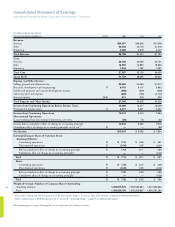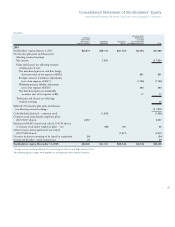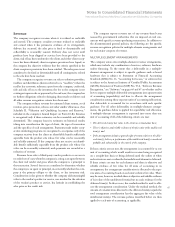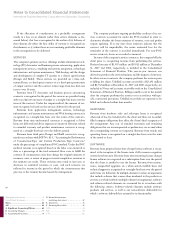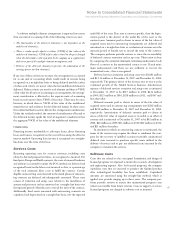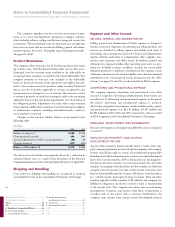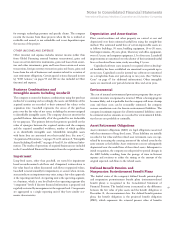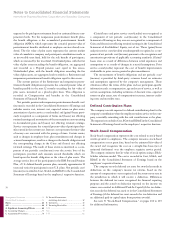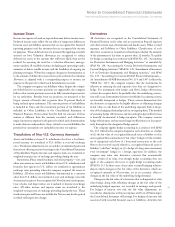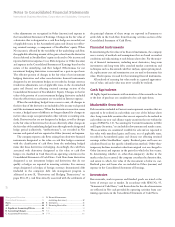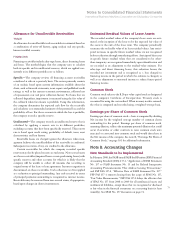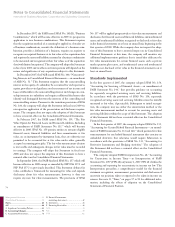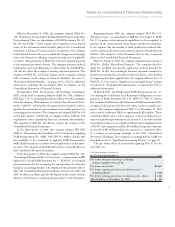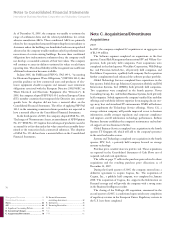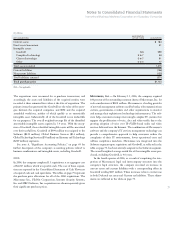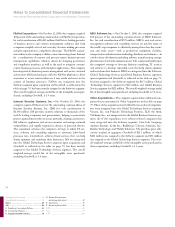IBM 2007 Annual Report Download - page 70
Download and view the complete annual report
Please find page 70 of the 2007 IBM annual report below. You can navigate through the pages in the report by either clicking on the pages listed below, or by using the keyword search tool below to find specific information within the annual report.
68
Notes to Consolidated Financial Statements
International Business Machines Corporation and Subsidiary Companies
Management Discussion ..................................14
Consolidated Statements ..................................58
Notes ........................................................... 64
A-F ............................................................. 64
A. Significant Accounting Policies ............ 64
B. Accounting Changes ...................................73
C. Acquisitions/Divestitures ............................76
D. Financial Instruments
(excluding derivatives).................................82
E. Inventories ...................................................83
F. Financing Receivables .................................83
G-M ..................................................................84
N-S ...................................................................94
T-W ................................................................102
The company capitalizes certain costs that are incurred to pur-
chase or to create and implement internal-use computer software,
which includes software coding, installation, testing and certain data
conversions. These capitalized costs are amortized on a straight-line
basis over two years and are recorded in Selling, general and admin-
istrative expense. See note I, “Intangible Assets Including Goodwill,”
on pages 84 and 85.
Product Warranties
The company offers warranties for its hardware products that range
up to three years, with the majority being either one or three years.
Estimated costs for warranty terms standard to the deliverable are
recognized when revenue is recorded for the related deliverable. The
company estimates its warranty costs standard to the deliverable
based on historical warranty claim experience and applies this esti-
mate to the revenue stream for products under warranty. Estimated
future costs for warranties applicable to revenue recognized in the
current period are charged to cost of revenue. The warranty accrual
is reviewed quarterly to verify that it properly reflects the remaining
obligation based on the anticipated expenditures over the balance of
the obligation period. Adjustments are made when actual warranty
claim experience differs from estimates. Costs from fixed-price support
or maintenance contracts, including extended-warranty contracts,
are recognized as incurred.
Changes in the warranty liability balance are presented in the
following table:
($ in millions)
2007 2006
Balance at January 1 $ 582 $ 754
Current period accruals 466 540
Accrual adjustments to reflect actual experience (29) 49
Charges incurred (607) (762)
Balance at December 31 $ 412 $ 582
The decrease in the balance was primarily driven by a reduction in
estimated future costs as a result of the divestiture of the Personal
Computing business to Lenovo Group Limited (Lenovo) in April 2005.
Shipping and Handling
Costs related to shipping and handling are recognized as incurred
and included in Cost in the Consolidated Statement of Earnings.
Expense and Other Income
SELLING, GENERAL AND ADMINISTRATIVE
Selling, general and administrative (SG&A) expense is charged to
income as incurred. Expenses of promoting and selling products and
services are classified as selling expense and include such items as
advertising, sales commissions and travel. General and administrative
expense includes such items as compensation, office supplies, non-
income taxes, insurance and office rental. In addition, general and
administrative expense includes other operating items such as a pro-
vision for doubtful accounts, workforce accruals for contractually
obligated payments to employees terminated in the ongoing course
of business, amortization of certain intangible assets and environmental
remediation costs. Certain special actions discussed in note Q, “2005
Actions,” on pages 99 and 100 are also included in SG&A expense.
ADVERTISING AND PROMOTIONAL EXPENSE
The company expenses advertising and promotional costs when
incurred. Cooperative advertising reimbursements from vendors are
recorded net of advertising and promotional expense in the period
the related advertising and promotional expense is incurred.
Advertising and promotional expense, which includes media, agency
and promotional expense, was $1,242 million, $1,195 million and
$1,284 million in 2007, 2006 and 2005, respectively, and is recorded
in SG&A expense in the Consolidated Statement of Earnings.
RESEARCH, DEVELOPMENT AND ENGINEERING
Research, development and engineering (RD&E) costs are expensed
as incurred.
INTELLECTUAL PROPERTY AND CUSTOM
DEVELOPMENT INCOME
As part of the company’s business model and as a result of the com-
pany’s ongoing investment in research and development, the company
licenses and sells the rights to certain of its intellectual property (IP)
including internally developed patents, trade secrets and technological
know-how. Certain transfers of IP to third parties are licensing/roy-
alty-based and other transfers are transaction-based sales and other
transfers. Licensing/royalty-based fees involve transfers in which the
company earns the income over time, or the amount of income is not
fixed or determinable until the licensee sells future related products
(i.e., variable royalty, based upon licensee’s revenue). Sales and other
transfers typically include transfers of IP whereby the company has
fulfilled its obligations and the fee received is fixed or determinable
at the transfer date. The company also enters into cross-licensing
arrangements of patents, and income from these arrangements is
recorded only to the extent cash is received. Furthermore, the
company earns income from certain custom development projects


